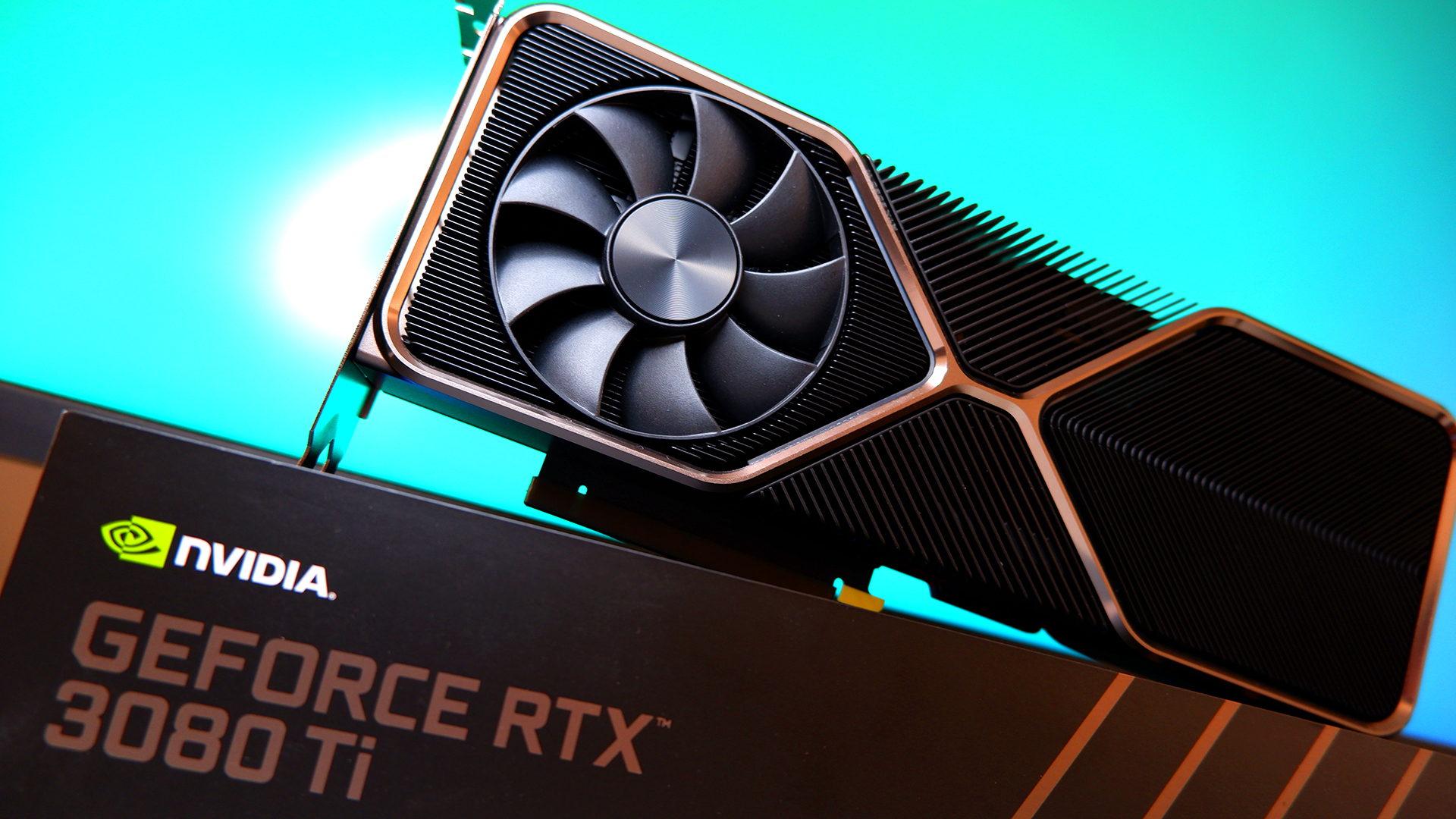Our Verdict
The GeForce RTX 3080 Ti is helluva graphics card for 4K gaming, in much the same way Nvidia's RTX 3090 is. However, a price tag closer to Ampere's finest—and far in excess of the RTX 3080—will see this card only finds its way into the most expensive PC builds around.
For
- More or less an RTX 3090 in games
- Breezy 4K performance
- Minimises ray tracing impact
Against
- Slimmer VRAM than RTX 3090
- Significantly pricier than an RTX 3080
- Thirsty for power
PC Gamer's got your back
Following months of mid-range and budget GPU launches from Nvidia, the latest graphics card out of the green team's skunkworks completely bucks that trend. The GeForce RTX 3080 Ti is destined for only the most powerful, most supercharged gaming PCs, and hopes to bring with it performance to crush the demands of 4K gaming once and for all.
Nvidia has offered a faster Ti graphics card that sat somewhere between the top card at the time and the all-powerful Titan for generations. It was this grudge match that would go on to decide which of the top graphics cards would find a home inside the godliest of PC builds: Do you spend nearly double the cash on a Titan card bragging rights or do you spare your change for a Ti, or perhaps two, to claim top performance?
Admittedly, times have changed. We're no longer pitting Titan versus GeForce, and you'll find few willing to recommend two $1,200 graphics cards for a single machine. But that's not to say the essence of this high frame rate slugfest isn't alive and well in 2021. The RTX 3080 Ti may not be quite the behemoth that the GeForce RTX 3090 is—either physically or technically—but I dare say it's good enough to earn a spot in enthusiast gaming PCs.
But is it enough card to make those who invested in an GeForce RTX 3080 over the past eight months whimper at what could've been? There will undoubtedly be a few willing to trade out their RTX 3080 for the Ti, yet I would guess for those who found the $1,499 RTX 3090 too pricey a purchase the same goes for the $1,199 RTX 3080 Ti.
At least the RTX 3080 Ti is not entering the fray with that much competition from the red team. There's the $999 Radeon RX 6900 XT, which sort of straddles the performance between the RTX 3080 and RTX 3090, although often tends to fall closer to the former in all but AMD optimised games. It is $200 cheaper than the RTX 3080 Ti, though remains an altogether too expensive graphics card for what you get.
That leaves just the top GeForce cards left to conquer. With a specs sheet straddling the RTX 3080 and RTX 3090, and the same Ampere architecture under the hood, it's no surprise then where the RTX 3080 Ti eventually ends up.
Specs

What are the Nvidia GeForce RTX 3080 Ti specs?
At the start of the year it appeared Nvidia was preparing to release an RTX 3080 Ti with altogether different specifications to the one before us today. It was said to contain a GPU and memory configuration that, in my mind, would have absolutely left the RTX 3090 whimpering in the dust. But a last minute shift—one which would see that unreleased card's GA102-250 GPUs returned back to GA102-300 stock—saw an end to that dream.
For a brief time afterwards the RTX 3080 Ti appeared as a graphics card locked in stasis. Then came reports of a GA102-225 GPU that now resides inside this final GeForce RTX 3080 Ti incarnation. It thankfully retains as much zeal for 4K gaming as you might expect from a $1,199 graphics card, if not quite the RTX 3090 killer on technicalities.
| Header Cell - Column 0 | RTX 3080 Ti | RTX 3090 |
|---|---|---|
| SM | 80 | 82 |
| CUDA Cores | 10,240 | 10,496 |
| GPU boost clock (MHz) | 1,665 | 1,695 |
| Tensor Cores | 320 | 328 |
| RT Cores | 80 | 82 |
| ROPs | 112 | 112 |
| Texture Units | 320 | 328 |
| VRAM | 12GB GDDR6X | 24GB GDDR6X |
| Memory Interface | 384-bit | 384-bit |
| Memory Bandwidth (GB/s) | 912 | 936 |
| Price | $1,200 / £1,050 / €1,200 | $1,500 / £1,400 / €1,500 |
The GA102-225 GPU is equipped with 80 SMs that, thanks to a doubling of FP32 units with the Ampere architecture, contain 10,240 CUDA Cores. That's only 256 cores shy of the RTX 3090's GA102-300 GPU, which tells you all you need to know about the computational firefight you can expect from these two.
With 80 SMs comes 80 of Nvidia's RT Cores, tailor-made for ray tracing. These are the second generation of RT Core found within Ampere, and are pretty effective for ray tracing acceleration—they're the best around today anyways, and outperform AMD's roughly equivalent first-gen Ray Accelerators.
Also included in the chip are 320 Tensor Cores, which are better suited to reduced precision operations used in machine learning. These are plenty useful in data centres for machine learning workloads, but for us gamers it's purely Nvidia's performance-pushing Deep Learning Super Sampling (DLSS) tech that will find a use for these bespoke cores.
Generally speaking, it's CUDA Cores and clock speeds that we care for most, and the RTX 3080 Ti has both where it counts. The Founders Edition manages a boost clock of 1,665MHz, although will exceed that in practice. Some judicious boosting baked into the card with Nvidia GPU Boost sees the card averaging a clock speed of 1,740MHz in Metro Exodus at 4K, only 26MHz slower than the RTX 3090 in the same run.
Then there's the memory capacity, and while it had looked for a while like Nvidia would stick 20GB of the good VRAM stuff on the RTX 3080 Ti, it's instead settled for a happy median of 12GB GDDR6X with the RTX 3080 Ti that's actually landed before us. That's half of the 24GB loaded onto the RTX 3090 yet an improvement on the RTX 3080's 10GB.
Therein surfaces an important distinction, at least from Nvidia's perspective. The RTX 3090 is built for creators and professionals using high demand applications, rather than gaming. Hence the massive memory pool. Granted, it's a little confusing since the RTX 3090 is a GeForce RTX 3090, and the GeForce brand has historically entailed the green team's gaming chips, but Nvidia would still have the RTX 3080 as the existing 'gaming flagship'. Now the GeForce RTX 3080 Ti is set to take that top spot.


Can't decide which ultra high-end graphics card to chase? Good for you. Here's our thoughts on the top cards to help make your mind up:
Nvidia GeForce RTX 3090 review
Nvidia GeForce RTX 3080 review
AMD Radeon RX 6900 XT review
AMD Radeon RX 6800 XT review
Visually, at least, the RTX 3080 Ti is more a match for the RTX 3080. The RTX 3080 Ti adopts a near-identical Founders Edition cooler and shroud to the one found on the RTX 3080.
There is one visible change in the shroud with the RTX 3080 Ti. The raised trim that circumvents both the heatsink and fans on the underside of the card are now shiny, as Nvidia is wont to do with fancy new versions of its GPUs (see: RTX 20-series Super). The I/O bracket is also covered in this shiny finish, as opposed to the matt black coat on previous Founders Edition 30-series cards.
The decision to retain the same Founders Edition cooler as the RTX 3080 also leaves the RTX 3090 as the only RTX 30-series card to arrive with its oversized jumbo shroud. As a result the RTX 3080 Ti does run notably hotter than the RTX 3090 over three runs of Metro Exodus: 75°C peak under load and averaging at 69°C to the RTX 3090 FE's 69°C under load and 65°C average temperature.
Otherwise, regarding the card's physical design, perhaps you'll be keen to hear the PCB for the Founders Edition will retain the unique V-shape cutout introduced with previous FE cards. Something to consider should you want to use a custom water block.
The proprietary 12-pin power connector isn't going anywhere, either, and a twin 8-pin power adapter is included in the box.
That brings us neatly onto power demands, and you'll need a fairly powerful PSU to run the RTX 3080 Ti without issue at 350W. Nvidia recommends a 750W PSU, so something similar at a minimum.
Lastly, while not listed as a 'Lite Hash Rate' or LHR graphics card, Nvidia is implementing its Ethereum mining limiter on all new graphics cards, including the RTX 3080 Ti. So if you were hoping to cash in on those CUDA Cores, you'll have to figure out how to get around the limiter first.
Performance

How fast is the Nvidia GeForce RTX 3080 Ti?
The GeForce RTX 3080 Ti is a picture of performance: For all the good the RTX 3080 does so far for 4K gaming, the RTX 3080 Ti does one better. For all the benefits of Ampere, the RTX 3080 Ti pushes them that much further. It's a card at the edge of performance, power, and cooling, but wrangles them all together so well in benchmarks.
I wouldn't say I'm surprised by how well the RTX 3080 Ti performs next to the RTX 3090—even the earliest rumours pegged the RTX 3080 Ti to be as much the gaming GPU as the RTX 3090—but there's certainly something to be said for how close the battle is. A minor overclock should be enough to put the RTX 3080 Ti ahead of the RTX 3090 Founders Edition, which will be achievable with the coming wave of third-party cards, likely for as much money. If not more.
4K performance
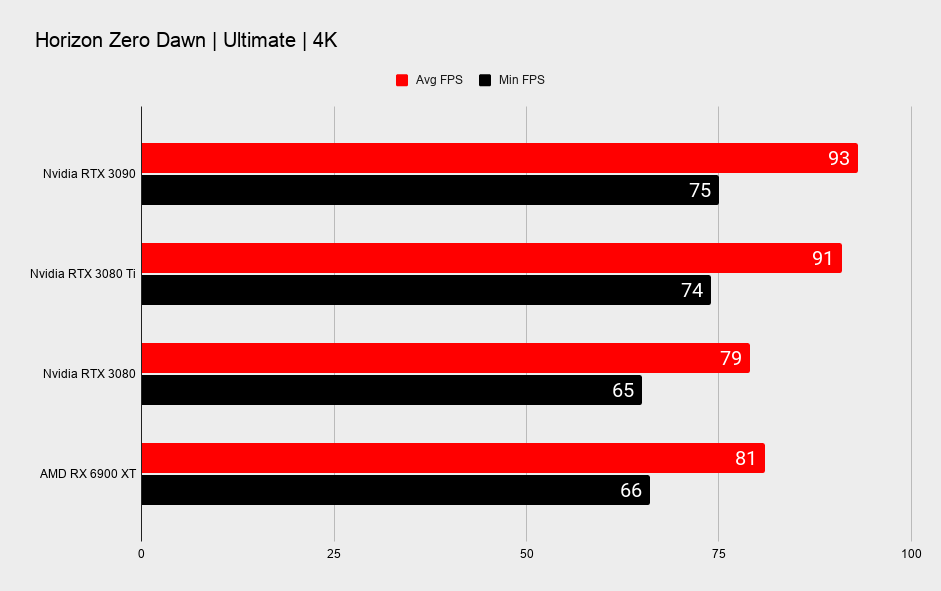







CPU - Intel Core i7 10700K
Motherboard - MSI MPG Z490 Gaming Carbon WiFi
RAM - Corsair Vengeance RGB Pro @ 3,200MHz
CPU cooler - Corsair H100i RGB Pro XT
PSU - NZXT 850W
Chassis - DimasTech Mini V2
The arrival of the Ampere generation did a lot to diminish the awkwardness or fiddly nature of 4K gaming, but the RTX 3080 Ti truly squashes it. Setting up for high performance 4K gaming remains a pricey investment, but you needn't be as cautious as we once had to be on a game-by-game basis. You can relatively comfortably set your game to high or ultra settings and get comfortable, even high, frame rates at 4K.
The last thing you want when gaming at 4K is to turn down graphics quality settings, and with the RTX 3080 Ti you shouldn't have to nearly as much as we've come to expect at 3840 x 2160.
The arrival of the Ampere generation did a lot to diminish the awkwardness of 4K gaming, but the RTX 3080 Ti truly squashes it.
Total War: Three Kingdoms is a partial exception to the rule, and there are sure to be a handful of games like it that simply do not deliver the smoothest frame rates at the utmost fidelity settings. Yet these are exceptions to the rule in the RTX 3080 Ti's case and appear few and far between.
The RTX 3080 Ti tends to fall a little behind the RTX 3090, although it appears the more expensive card only sees marginal benefit for an increase in core counts and memory—the RTX 3080 Ti is only single percentage points off the pace.
Then there's the RTX 3080 trailing the Ti by around 10-20%, depending on the game in question. That said, the Ti is $500 pricier than the RTX 3080, a 71.5% price increase, so while a much faster card, the Ti will require serious thought as to whether you really need all that power or if your PC upgrade cash is better spent elsewhere.
1440p performance
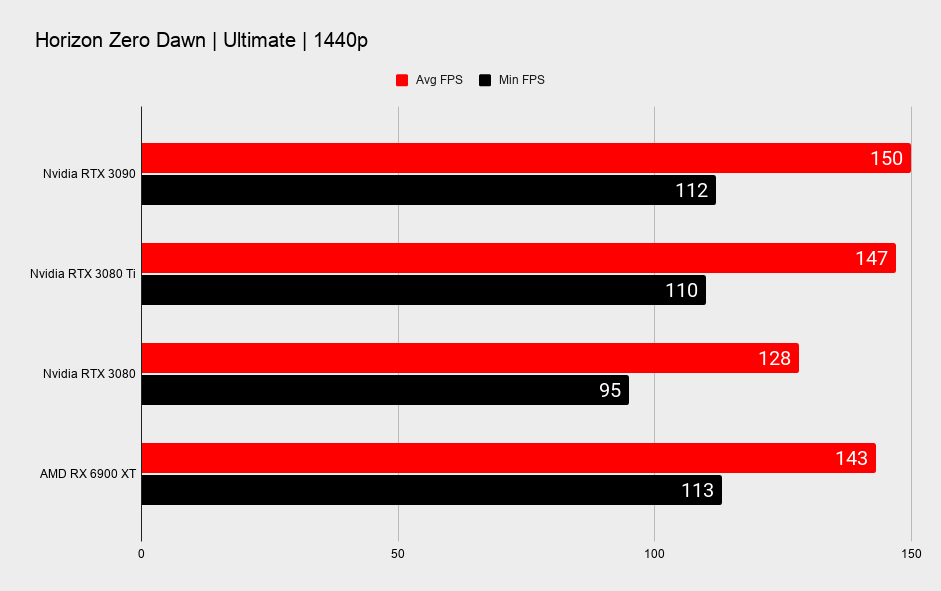






The RTX 3080 Ti is frightfully good at 1440p, and frame rates in the triple digits are commonplace. No doubt this card would be well-suited to gaming monitor co-opting the fidelity benefits of 1440p and blisteringly quick refresh rates.
As with the battle at 4K, it's a close run contest between the RTX 3080 Ti and RTX 3090 at 1440p. In a couple of games you can see the RTX 3090 slip ahead—Total War, Horizon Zero Dawn—but more often than not it maintains a steady pace within a frame or two of the pricier card.
One thing that is entirely consistent is the Ti's lead over the RTX 3080. While by no means slow, the RTX 3080 just isn't able to keep abreast of the 3080 Ti. Calling this out is, of course, pointing out the obvious; the RTX 3080 is much the same card with mechanically fewer cores and less memory. Granted, it clocks higher than the Ti, but that can't surmount its deficits elsewhere.
AMD's RX 6900 XT also finds its footing at 1440p a little more, and while the performance of that GPU can really vary title to title, it can be found toe-to-toe with the RTX 3080 Ti and RTX 3090 at times. Something to be said for this $999 GPU, which seemed altogether too expensive at time of launch but appears just that tiny bit more reasonable with the launch of the RTX 3080 Ti.
1080p performance


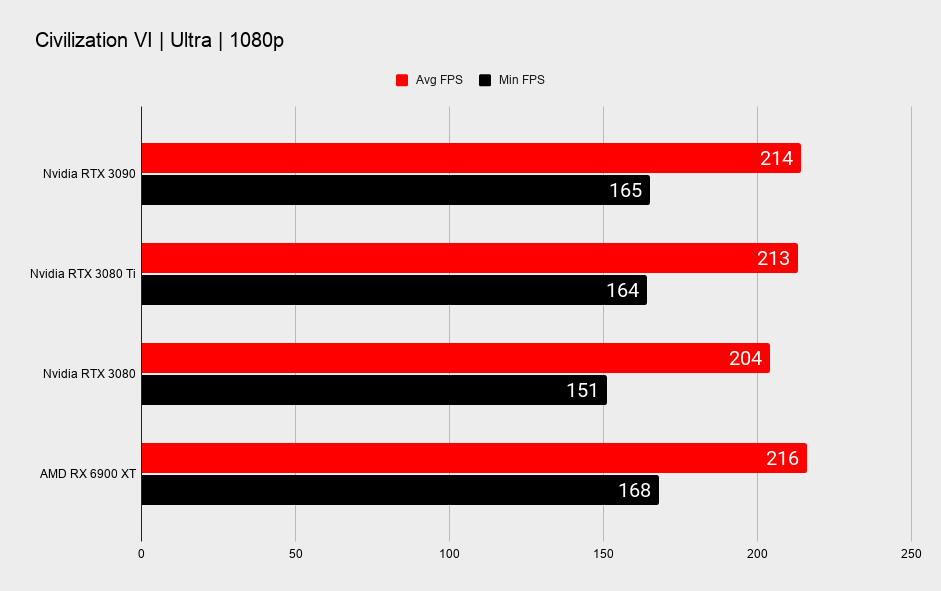




The gap between all of these top performers closes up considerably at 1080p, as one might expect for the more CPU-bound resolution. That said, you can clearly see the lift in performance between the RTX 3080 Ti and RTX 3080 even at lower resolution, meaning Nvidia's second-run RTX card's raw core capacity is serving it well here. I'd be surprised if the extra 2GB of memory really made much of a difference at 1080p.
I doubt there are many out there looking at the RTX 3080 Ti to solely enjoy 1080p gaming, but some may wish for an overpowered rig to hit 240-360Hz on competitive titles, and for that, the RTX 3080 Ti is unsurprisingly awesome if wholly overkill.
Yet AMD's RDNA 2 architecture also appears a little more performant at 1080p, which leaves Nvidia's two pricier options a little worse for wear versus the cheaper RX 6900 XT. At this price point success at 1080p arguably means the least, but it goes some way to explaining why we're suddenly seeing performance favouring team Radeon after some comfortable wins for Nvidia at 4K and 1440p.
There is an oddity worth mentioning here, however, that's Wolfenstein Youngblood. For all my attempts this Vulkan-powered game would not perform as you'd imagine on the RTX 3080 Ti, which I'd likely chalk up to something software or driver related seeing as all our other results show it with a solid lead.
Ray tracing performance
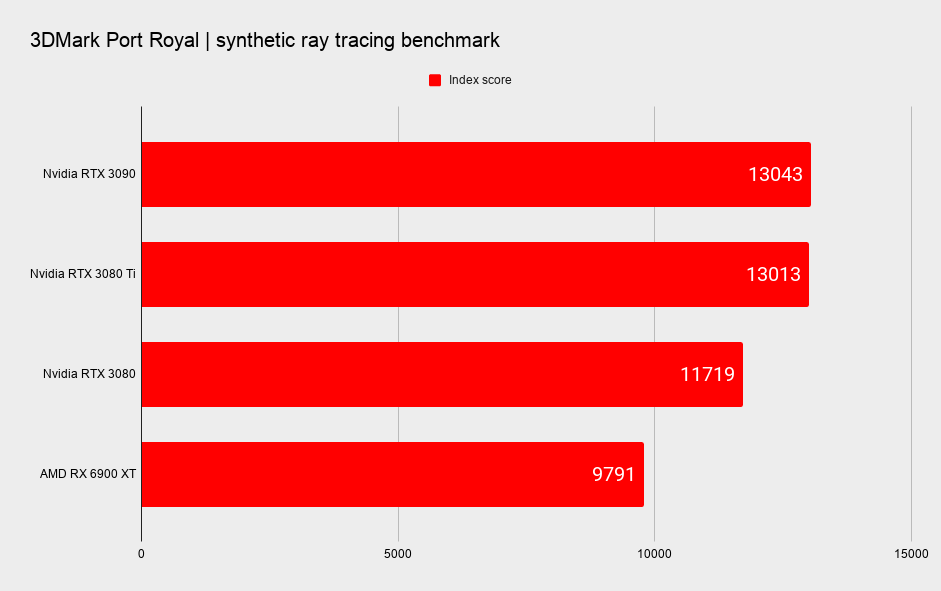


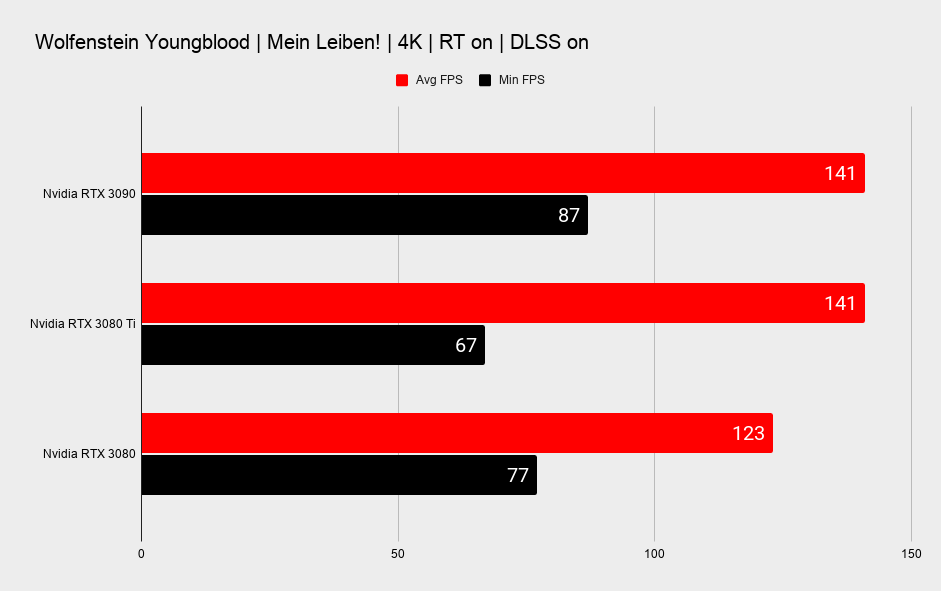






Only two SMs separate the RTX 3080 Ti and its bigger sibling, the RTX 3090, hence the resulting 256 CUDA Core deficit on the former. Yet that only makes for two fewer 2 RT Cores on the cheaper card.
The remaining 80 RT Cores on the RTX 3080 Ti make easy work of the Port Royal benchmark—a hybrid rendering benchmark—but similarly crushes it in the purely ray-traced DirectX Raytracing feature test.
So if you were thinking of picking up the RTX 3090 on purely ray tracing terms, I would recommend against it. The RTX 3080 Ti is nearly as much a match in silicon, and only negligibly worse in practice.
Furthermore, DLSS proves yet again to be an important tool in the PC gaming toolkit for improving frame rates. We've finally word of AMD's analogue in FidelityFX Super Resolution, yet a collection of popular games supporting DLSS certainly sees it edge some favour in my books, as it stands today. Ideally we'd find a lot more games offer support for both solutions.
Thermal and power performance



The RTX 3080 Ti is not a particularly surprising graphics card, perhaps least so when you look at its key vitals during operation. At 350W, it's up there with the RTX 3090 in terms of power consumption—it's clocked slightly lower, and that stay from the ragged edge perhaps helps it save a little more energy than its bigger sibling, but it's not much more power-savvy either way.
The Founders Edition cooler all but ripped from an RTX 3080 does a fine job of keeping the larger chip cool, too. The RTX 3090's colossal cooler does an even better job, mind you, but its mass really is a sight to behold.
The RTX 3080 Ti shroud not only gets the job done, it looks decent doing it. I feel the shiny finish may be a little divisive (the RTX Super shrouds were really hit or miss), but as a fan of the Super line-up I nary mind it much. I'd even say it's quite nice.
Analysis

What does the Nvidia GeForce RTX 3080 Ti mean for PC gaming?
The Nvidia GeForce RTX 3080 Ti is as much the all-powerful graphics card you'd expect it to be, but it doesn't shake up the current graphics card market to any great extent.
That's partially because there's not much of a graphics card market to speak of right now and price-to-performance ratios are all out of whack, but it also feels like Nvidia has decided to cautiously spike the price of the RTX 3080 Ti to avoid cannibalising the sales of RTX 3090 cards, as opposed to what could've been a more reactionary price tag to fend off any further advances by AMD.
I can't help but feel that if the $999 RX 6900 XT was able to go toe-to-toe with the RTX 3090 with more consistency, we would be looking at a cheaper card in the RTX 3080 Ti. As it stands, Nvidia retains the upper hand and isn't feeling pressured on pricing. Instead it's the existing Ampere generation that Nvidia has to work around with the RTX 3080 Ti, and Nvidia's parachuted the RTX 3080 Ti in right on target between the RTX 3080 and RTX 3090 to keep both as viable as ever.
Perhaps few gamers with any intent to purchase an RTX 3080 Ti will give two hoots about the more responsible option that is the RTX 3080—a card that remains just "****ing great" as the day it launched. The RTX 3080 is, as ever, the sensible choice. As a competitor to the $1,499 RTX 3090, though, the RTX 3080 Ti FE delivers something awfully close for $300 less.
The inevitable increase in price with third-party cards, and the likely scarcity of stock, will no doubt see the gap between the RTX 3080 Ti and the RTX 3090 shrink, and likely to a point where the two are indistinguishable in price. In that case, Ampere's Titan-a-like RTX 3090 is the materially better card—even if gamers may not often reap the benefits of its more generous memory buffer—and that could put the RTX 3080 Ti in a bit of a pinch down the line.
That said, if you can pick up an RTX 3080 Ti Founders Edition at launch, for MSRP, you'll be snagging a deal so good we may never see anything like it for the duration of this card's lifespan.
Verdict

Should you buy the Nvidia GeForce RTX 3080 Ti?
The GeForce RTX 3080 Ti remains an impressively powerful graphics card despite some inflexibility ingrained in the price—it will see some save a few pennies on ultra-high-end gaming PC builds and still claim top performance. The Ampere architecture is excellent, and stuffing more of it under that unassuming black and (polished) grey shroud simply makes for a great gaming chip.
It does, then, achieve what it set out to do: break the back of just about any game, API, or graphics-intensive task, even at 4K, and do so in a way that appeals direct to gamer's sensibilities. Though it's not quite the high-end price-to-performance champion the RTX 3080 is, the RTX 3080 Ti FE is in small part a better buy than an RTX 3090 FE.
For how long it will retain that small victory, who can say? The RTX 3080 Ti, like all those before it, is fodder for a GPU market in turmoil, and even barring any stock concerns the RTX 3080 Ti Founders Edition itself is a limited run. At some point, custom cards will be all that's available, if any, and high price tags for those chips from Nvidia's partners may diminish the only benefit the RTX 3080 Ti can claim over the RTX 3090.
Historically the Titan killer of a generation, the RTX 3080 Ti delivers more of a light shove to the RTX 3090 Titan-a-like than a knife through its heart. It is, however, a venerable graphics card for 4K gaming, and with its launch comes another bite at the cherry for GPU-starved gamers, which is at least worth something in these dire times.
The GeForce RTX 3080 Ti is helluva graphics card for 4K gaming, in much the same way Nvidia's RTX 3090 is. However, a price tag closer to Ampere's finest—and far in excess of the RTX 3080—will see this card only finds its way into the most expensive PC builds around.

Jacob earned his first byline writing for his own tech blog. From there, he graduated to professionally breaking things as hardware writer at PCGamesN, and would go on to run the team as hardware editor. He joined PC Gamer's top staff as senior hardware editor before becoming managing editor of the hardware team, and you'll now find him reporting on the latest developments in the technology and gaming industries and testing the newest PC components.
